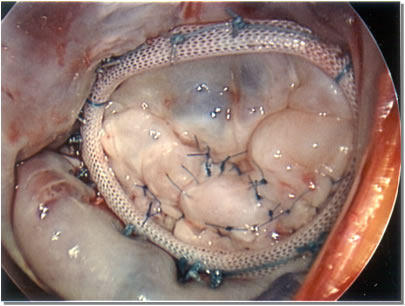“Do All Mitral Valve Repairs Involve An Annuloplasty Ring?” asks Ann
Written By: Adam Pick, Patient Advocate & Author
Medical Expert: Steven Bolling, MD, Cardiac Surgeon, Michigan Medicine
Published: February 8, 2022
We just received a great question from Ann about surgical mitral valve repairs and the use of annuloplasty rings to treat mitral regurgitation. In her email, Ann asked, “Hi Adam – Do all mitral valve repairs involve an annuloplasty ring?”
That is a great question. I wanted to provide Ann an expert response. For that reason, I interviewed Dr. Steven Bolling, a leading mitral valve surgeon at Michigan Medicine in Ann Arbor, Michigan. During his career, Dr. Bolling has performed over 7,000 cardiac procedures of which more than 5,000 involved heart valve repair and replacement therapies. You should also know that Dr. Bolling is an innovator in the field of mitral valve surgery having developed several devices to advance valvular therapy.
Key Learnings About Mitral Valve Repair Rings
Here are several important learnings from our discussion with Dr. Bolling:
- According to Dr. Bolling, all surgical mitral valve repair procedures should involve the use of a mitral valve annuloplasty ring.
- The annuloplasty ring is critical for the long-term durability of a mitral valve repair operation as it reinforces the annulus and helps maintain the integrity of the mitral valve structure, its annulus and the function of the mitral leaflets.
- Dr. Bolling indicates that annuloplasty rings helps maintain the diameter of the mitral valve as well. In patients with severe mitral regurgitation, the annulus diameter can measure over 4 centimeters. In comparison… Dr. Bolling, who is very tall, has a mitral valve annulus that is only 2.5 centimeters in diameter.
- Annuloplasty rings are very durable and designed to outlive the lives of the patients who receive them. As Dr. Bolling stated, “What I tell my patients is when I’m dead, I’ll be a pile of dust. When they’re dead, they’ll be a pile of dust and a little ring. It’ll be there. It’s part of them.
 Implanted Annuloplasty Ring
Implanted Annuloplasty Ring
Many Thanks Dr. Bolling & Michigan Medicine
On behalf of our patient community, many thanks to Dr. Steven Bolling for taking the time to share his clinical research and experience with us. In addition, we would like to thank Dr. Bolling and the entire Michigan Medicine team for taking such great care of the patients from HeartValveSurgery.com.
Keep on tickin!
Adam
P.S. For the hearing impaired members of our community, I have provided a written transcript of my interview with Dr. Bolling below.
Video Transcript:
Adam Pick: Hi, everybody. It’s Adam with heartvalvesurgery.com. Today we’re answering your questions all about mitral valve repair surgery. I am thrilled to be joined by Dr. Steven Bolling who is a leading cardiac surgeon at Michigan Medicine in Ann Arbor, Michigan. During his extraordinary career, Dr. Bolling has performed over 7,000 cardiac procedures of which more than 5,000 involved some form of heart valve repair or heart valve replacement. Dr. Bolling, thanks as always for being with us today.
Dr. Bolling: Adam, good to see you again. It’s great to be with you. Great to see everybody on heartvalvesurgery.com.
Adam Pick: Yeah, and so we’re answering patient questions, Dr. Bolling. This one came in from Ann. She says, “Do all mitral valve repairs involve an annuloplasty ring?”
Dr. Bolling: Adam and Ann, that’s a really great question. The short answer is yes, yes, they do. You should put a ring on it because Beyonce says put a ring on it. Put a ring on it. Why we put a ring on it is very interesting. This is for patients who have their mitral valve leaking. They have mitral regurgitation. The ring is there is to reinforce the annulus. If you think of it, when your valve is leaking, you’re putting a significant amount backwards and of course, you’re putting it forwards. If you think about it, roughly, a human will put 60 millimeters with each and every heartbeat forward, 60, and hopefully, you’re putting zero backwards. Now when your valve is leaking a lot, you’re putting both 60 forward and 60 backwards. If you add that up, what the heart does is says, oh, my gosh, I have to move 120 millimeters of blood to keep this patient alive.
Now what happens is the heart starts to expand and it pulls the native annulus apart. Now, whatever has caused that leakage we can fix. We do something to the leaflets. We put cords on them. We fix it one way or the other, but when we’re done, we want to have that annulus about this size. That is about the size of my mitral annulus. If you look at it, ask Adam, I’m very tall. My annulus is only about 2.5 or 2.6 centimeters across. Now some of the patients with mitral regurgitation we measure and that diameter has now become four centimeters across. It’s pulled open. Whatever we do to get that roman arch to get the leaflets to come up and catch normally, once we’re done with that, we have to pleat that forward to get it to this size, but then to hold it in that size, we sew a ring on there that’s reinforced because we have to assume that that native annulus has become like a broken rubber band. It’s overstretched. It will just keep going and then you’re leaking again a year later, five years later, and that’s no good.
We put that ring on there. That ring stays in there forever. Within about 30 days, that becomes part of you. What I tell my patients is when I’m dead, I’ll be a pile of dust. When they’re dead, they’ll be a pile of dust and a little ring. It’ll be there. It’s part of them. That’s why we put an annular ring on everybody. In fact, the data shows that if you don’t put a ring on, your recurrence rate is much higher, maybe eight or ten times higher.
Adam Pick: That is absolutely fascinating. I hope that helped you, Ann, learn why Dr. Bolling and mitral valve experts use annuloplasty rings. Dr. Bolling, as always, thanks so much for taking the time away from your very busy practice there at Michigan Medicine in Ann Arbor to help educate all the patients here at heartvalvesurgery.com.






